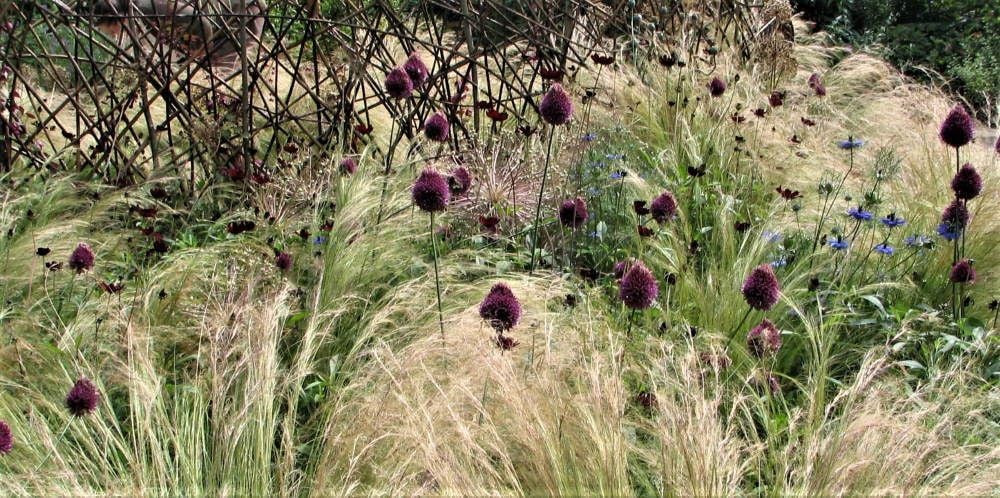
Best plant and Ornamental Grass Combinations
Grasses combine well with many perennials to stunning effect. The image above shows Stipa tenuissima, a grass with wispy flower heads, combined with Allium sphaerocephalon, blue cornflowers, and the seed heads of Allium cristophii to create a fine late summer display.
If you are looking for inspiration to see displays of grasses in a garden setting, the RHS latest flagship garden in Manchester Bridgewater has fantastic planting arrangements using various grasses.
More about How and Where to Grow Ornamental grasses
Below are some easy to grow combinations of perennials and decorative grasses.
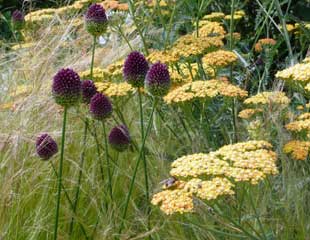
Stipa tenuissima, Allium and Achillea
This is a great combination which is at its best in July and August. Planted alongside the S. tenuissima is the late flowering Allium sphaerocephalon and terracotta Achillea.
For this combination to work, the choice of Allium is important because many Alliums are spring flowering in May, and for this combination it is essential to plant the late summer flowering Allium which is A. spaerocephalon, which will flower in July and August. Plant this combination in a sunny spot with well-drained soil and it should return reliably each year.
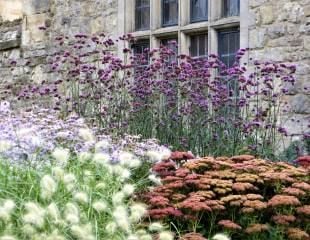
Verbena bonariensis, Sedum, Aster and Pennisetum
This combination needs a sheltered spot only because this variety of Pennisetum is not fully hardy, only H3, which is coastal gardens and milder areas. It combines here well with the reliable perennials Verbena, tall purple spires and pale mauve Aster with the dark Autumnal shades of Sedum. This is an easy to grow combination if you have a sheltered spot and was spotted growing in a walled area of garden in an Oxford college. A hardier substitute for the Pennisetum would be Stipa tennuissima or Deschampsia to create a fully hardy combination.
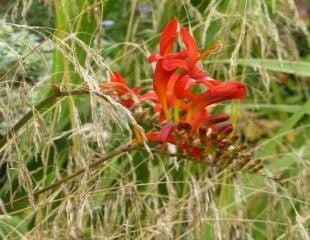
Crocosmia and grasses.
Crocosmia looks good with certain grasses as they reflect and share with chosen grasses the arching habit. The variety illustrated is C. Lucifer, which is tall and looks good teamed up with tall grasses, such as Stipa gigantea, or perhaps Stipa ichu, as both have an arching habit.
The smaller yellow and orange varieties of Crocosmia also work well and grasses such as Deschampsia cespitosa and Molinia caerulea, purple moor grass, look good together. Both Crocosmia and the grasses are easy to grow, simply plant in a sunny spot although the taller Crocosmia may require staking.

Teasel
Although not actually a grass, Teasel looks great planted with grasses and is a native to the UK. It is a self seeding biannel which grows up to around a meter plus with very attractive seed heads.
Not only do we like them, but bees find them a good source of nectar during the summer flowering months, insects live in them, and goldfinches love the seed heads. Teasel make a great structural plant, especially in a wildlife area. They will self seed, and you may need to keep them in check .
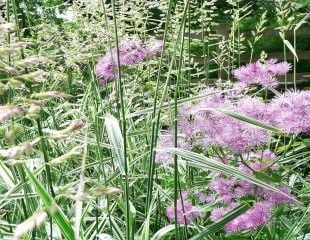
Thalictrum aquilegiifolium and Phalaris arundinacea
Most grasses like a sunny spot, but this is a combination for damp ground and partial shade. Thalictrum (common name meadow rue) is an easy to grow perennial. Phalaris arundinacea, common name gardener's garter, has leaves with a mauve tinge which tones in well with the Thalictrum. It is also easy to grow and both plants are fully hardy. It can be vigorous, which means it is only suitable for large spaces, but ideal ground cover where needed.
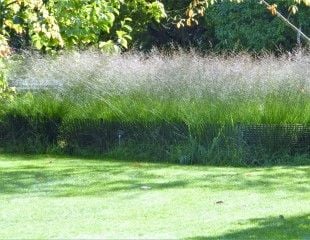
Molinia en masse
An effective planting scheme can be to repeat plant the same grass, as illustrated in this image, creating a shimmering wall of Molinia. This was a planting scheme at the Hillier garden in Hampshire and it looked really effective, especially with the sun catching the grasses.
Repeat planting of a single plant can be eye-catching. Check out plants for shade to see shuttlecock ferns planting in large groups looking very effective.
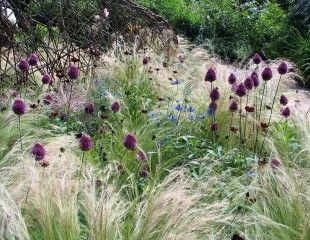
Stipa tenuissima, Allium, Nigella and Cosmos
This is a combination found one year at RHS Harlow Carr and it is stunning. The soft flow of the Stipa tenuissima, purple heads of Allium, blue Nigella also known as love-in-the-mist, and chocolate Cosmos.
The Allium and Stipa are easy to grow in any sunny spot, Nigella an annual, would need to be resown each year. One drawback of this variety of Cosmos is it is not fully hardy H3, and the tubers need to be lifted over winter.
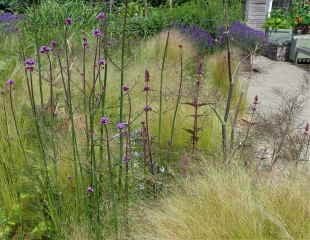
Stipa tenuissima and verbena bonariensis
Idea dry planting combination of Stipa tenuissima and verbena bonariensis, the bronze of the grasses tones with purples in this case Verbena.
Ideal for a low maintenance dry area note that different varieties of Verbena vary in height and some are annuals.
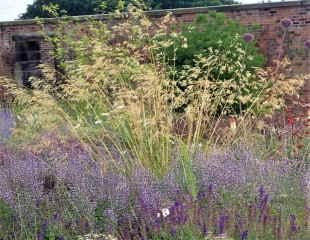
Stipa Gigantea, with calamintha sylvatica, agastache
Another bronze/purple combination, this time Stipa gigantea with light mauve calamintha and darker purple of Agastache which is much loved by bees. All are frost hardy and perennial.
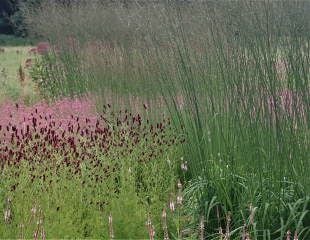
Molinia grass with Sanguisorba and purple loosestrife
A great combination for a semi wild setting and all are easy to grow. The Burnett will attract bees, and the loosestrife both bees and butterflies.
Towering over the planting is shimmering Molinia grass to make a lovely Great Burnet and purple loosestrife
